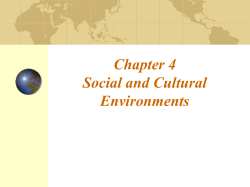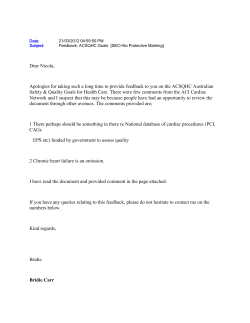
CHAOS THEORY
CHAOS THEORY Edge of Chaos: Complexity theory is not the same as chaos theory, which is derived from mathematics. But chaos does have a place in complexity theory in that systems exist on a spectrum ranging from equilibrium to chaos. A system in equilibrium does not have the internal dynamics to enable it to respond to its environment and will slowly (or quickly) die. A system in chaos ceases to function as a system. The most productive state to be in is at the edge of chaos where there is maximum variety and creativity, leading to new possibilities. COMPLEX ADAPTIVE SYSTEMS A Complex Adaptive System (CAS) is a dynamic network of many agents (which may represent cells, species, individuals, firms, nations) acting in parallel, constantly acting and reacting to what the other agents are doing. The control of a CAS tends to be highly dispersed and decentralized. If there is to be any coherent behavior in the system, it has to arise from competition and cooperation among the agents themselves. The overall behavior of the system is the result of a huge number of decisions made every moment by many individual agents. (John Holland) COMPLEX ADAPTIVE SYSTEMS BEETLE TO BEEHundreds of the parasitic larvae clump together in the shape of a female bee. When the male bee arrives to mate the larvae attach themselves the the chest of the male bee and are carried off. When the male bee mates with a real female bee the larvae transfer to her and ride off to the nest where the feast on the pollen. This behavoir is virtually unknown in the insect world expcept with social species such as bees and ants. The larvae must also smell like a female bee as the male bee will not fool by a model. These situations are performed with out any leaders or external influence. TRANSCENDENT FUNCTION A psychic function that arises from the tension between consciousness and the unconscious and supports their union. When there is full parity of the opposites, attested by the ego's absolute participation in both, this necessarily leads to a suspension of the will, for the will can no longer operate when every motive has an equally strong countermotive. Since life cannot tolerate a standstill, a damming up of vital energy results, and this would lead to an insupportable condition did not the tension of opposites produce a new, uniting function that transcends them. This function arises quite naturally from the regression of libido caused by the blockage.[Ibid., par. 824.]The tendencies of the conscious and the unconscious are the two factors that together make up the transcendent function. It is called "transcendent" because it makes the transition from one attitude to another organically possible.["The Transcendent Function," CW 8, par. 145.] TRANSCENDENT FUNCTION In a conflict situation, or a state of depression for which there is no apparent reason, the development of the transcendent function depends on becoming aware of unconscious material. This is most readily available in dreams, but because they are so difficult to understand Jung considered the method of active imagination-giving "form" to dreams, fantasies, etc.-to be more useful. Once the unconscious content has been given form and the meaning of the formulation is understood, the question arises as to how the ego will relate to this position, and how the ego and the unconscious are to come to terms. This is the second and more important stage of the procedure, the bringing together of opposites for the production of a third: the transcendent function. At this stage it is no longer the unconscious that takes the lead, but the ego.[Ibid., par. 181.]This process requires an ego that can maintain its standpoint in face of the counterposition of the unconscious. Both are of equal value. The confrontation between the two generates a tension charged with energy and creates a living, third essence. TRANSCENDENT FUNCTION From the activity of the unconscious there now emerges a new content, constellated by thesis and antithesis in equal measure and standing in a compensatory relation to both. It thus forms the middle ground on which the opposites can be united. If, for instance, we conceive the opposition to be sensuality versus spirituality, then the mediatory content born out of the unconscious provides a welcome means of expression for the spiritual thesis, because of its rich spiritual associations, and also for the sensual antithesis, because of its sensuous imagery. The ego, however, torn between thesis and antithesis, finds in the middle ground its own counterpart, its sole and unique means of expression, and it eagerly seizes on this in order to be delivered from its division.["Definitions," CW 6, par. 825.] TRANSCENDENT FUNCTION The transcendent function is essentially an aspect of the selfregulation of the psyche. It typically manifests symbolically and is experienced as a new attitude toward oneself and life. If the mediatory product remains intact, it forms the raw material for a process not of dissolution but of construction, in which thesis and antithesis both play their part. In this way it becomes a new content that governs the whole attitude, putting an end to the division and forcing the energy of the opposites into a common channel. The standstill is overcome and life can flow on with renewed power towards new goals.[Ibid., par. 827.] ABAISSEMENT DU NIVEAU MENTAL THIS IS THE CONCEPT OF LOWERING THE “HABITUAL CONSCIOUSNESS”OF EVERYDAY LIFE IN ORDER TO EXPERIENCE THE DEEPER LAYERS OF THE PSYCHE. TO EXPERIENCE MOMENTS OF “AHA! MOMENTS THAT FEEL OUTSIDE OF TIME AND SPACE ARCHETYPAL EXPEREINCES FEELINGS OF HARMONY, RESONANCE EXPEREINCES BEYOND THE RATIONAL AND LOGICAL MIND SYNCHROICITY AND THE INTERACTIVE FIELD •THE OBSERVER AND THE OBSERVED •MIRROR NEURONS •RESONANCE •EMPATHY
© Copyright 2025















